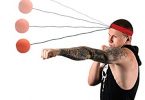If you have not worked with a punching bag and don't have wealth of experience in boxing or MMA, working with a punching bag can be a bit intimidating. What type of punching bag to get? What punching bag types are even out there? Hopefully, we can provide enough information on the types of punching bags so you feel more comfortable with this topic. We'll provide tips for speed bags, slip balls, freestanding heavy bags and others. First, let's start with a brief into on punching bags.

Punching Bag Types
Most people are able to name a few punching bag types. For example, heavy bag and speed bag being the top choices. Boxing and MMA have evolved over the years, which includes the types of fighting gear that you may find. You might be surprised to learn that there are almost 10 types of punching bags!
The reason for different punching bags is that some of them are tailored better for specific aspects of training. Some of them will let you develop punching power whilst others will focus on your boxing footwork. Here are the types of bags out there.
Heavy Bag

Heavy bag is the most well known type of bag. The term heavy bag actually classifies all types of free-hanging bags. They certainly vary in how heavy they are. Meaning, they don't have to weight a lot to be considered heavy. Heavy bag is an excellent way to practice movment, general punching power, combinations. The beautiful aspect of free-hanging bag is that it moves around! This requires fighter to adapt to a moving target. The adaptation can be done in various ways: through footwork, slipping to sides. Punches can be thrown at various angles whilst moving. The heavy bag also lets you develop punching power because of the resistance it offers.
Heavy bag training is always a part of fighter training because of the training flexibility it offers. It also is a perfect way for enthusiasts to stay busy as the exercise you can get out heavy bag work is amazing!
Speed Bag
In terms of popularity, speed bag is right next to heavy bag. Some of the iconic training videos that boxers have include speed bags. This punching bag comes with a bit of flashiness. The professional boxers can be seen using speed bag with their eyes closed, throwing punches only with one hand as well as looking away from the bag whilst training. It certainly looks impressive but there's more to speed bag than just being able to impress someone.
The words speed bag might be a little bit deceiving. The main purpose of this punching bag isn't to develop punching speed. There are other methods that help develop punching speed much better than the speed bag. To punch speed bag continuously in a rhythm helps develop hand-eye coordination. To be able to continuously deliver a punch at the right time, you'll develop good timing to your punches. It also helps train cardio because you're throwing a high number of punches. This is a fun training method. What speed bag isn't for is developing combinations, footwork and power. It's a bag that lets you train your punching fitness (e.g. throwing punches at a high volume) along with hand-eye coordination and timing.
Double End Bag (or Floor to Ceiling Bag)

Double end punching bag would have to rank right after the two previous punching bags, in terms of popularity. This bag provides more functional training that the speed bag but it draws some parallels with it. This punching bag type has the words double end to it because it's meant to be fixed both at the top and bottom. Unlike the heavy punching bag, which is only attached at the top. Hence the alternative name to this bag - a floor to ceiling bag. So why attach a bag from both ends? That's where this punching bag shines and provides very interesting problem to solve.
When punching a double end bag, due to its range of motion being fixed at the top and bottom, it has a quick bounce. After a punch, it quickly moves away from you and will return bag sharply. To be able to punch the bag quickly the second time, fighter has react quickly and time the punches well. And that's where it excels at. It lets you train timing, accuracy and speed. You can throw combinations with it and even practice a bit of footwork. You're not going to really develop punching power with this punching bag type. But you will definitely exercise other aspects of fighting that were mentioned earlier. Last but not least, it is also great for training your reaction for slips. After each punch, instead of hitting it on first return, you can throw in a slip to avoid taking a hit from the ball. This type of punching bag, similar to heavy bag, is quite universal and can let you practice many aspects of fighting.
Slip Bag
Slip bag (also known as maize bag) is completely different type of bag. It typically isn't used for punching so classifying as punching bag would be a little stretch. Having said that, it definitely offers some unique benefits that the other bags don't offer. Sure, it may not help you with your punching speed, power and timing but that's not what this bag is for. This bag is actually to practice slips (hence the name, slip bag). Everyone who enters the world of boxing or MMA tends to start practicing punches and kicks. It certainly is an important aspect of fighting but let's not forget the main two rules of fighting: hit and don't get hit. There are many bags to address the hitting part but this is really the only one targeted for slipping only.
It works with a very simple principle, you push the bag away and as it comes back towards you, simple slip. It indeed it is no rocket science when it comes to the slip bag. The benefits of this bag start to shine when you throw in shadow boxing. When it comes to shadow boxing, it's up to the practitioner of it to visualize the opponent. Slip bag can be very helpful to practice shadow boxing with an imaginary opponent but you get to slip and actual object. Being able to slip instantaneously in a fight is extremely important and that can be only done when you've trained your muscle memory to perform a slip thousands of times. This is what the slip bag helps you achieve.
Uppercut Punching Bag

Similar to the slip bag, uppercut bag's purpose is revealed in its name. Its main purpose is to help develop uppercuts. Typically these bags are also quite heavy to let you throw heavy uppercuts. There are variations of the uppercut bag. Some uppercut bags are very round and some resemble a heavy bag with an angled top part of the bag to let you land uppercuts. Uppercut bag solves a particular problem that heavy bags have - it's difficult to throw an uppercut at a bag when your target is perpendicular to the ground. To amplify the example here, imagine throwing an uppercut at a wall. It's impossible. Although a heavy bag lets you sink in the knuckles and it won't bounce off like a shot at a wall would, I'm sure you understand the issue here. You'll certainly see people throwing uppercuts in the gym using a heavy bag but these punches usually are not clean uppercuts. You can't practice developing powerful uppercuts when there is no resistance to push against upwards. Heavy bag doesn't provide upward resistance, so the best you can do with upppercuts on a heavy bag is either throw it without power, or do some kind of body shot instead.
It should be noted that whilst the name indicates its purpose, uppercut bag is also an excellent bag to use to to train all other punches except body shots. You can practice hooks, jabs, crosses and mix in uppercuts. And just like a heavy bag, you can definitely practice footwork whilst throwing your shots. So as you can tell, this is a extremely versatile bag for martial arts training and can be used in many ways to develop your skills.
Wall bag
Wall bag is another type of punching bag that adds a little something that the other bags fail to do. As the name indicates, the bag is mounted to a wall. It's actually not a bag but more of a padded block. There are a few types out there but most common one is an P shaped wall bag. So what is special about the wall bag and how it is different from other types? The most unique aspect of the wall bag is that unlike other bags, this one stays stationary and does not move at all. Why would you want a bag that doesn't move? There are times when you want the bag to move, since a moving target reflects better an actual opponent. But there are times when you want to focus on the execution of your punch, footwork or combinations and you don't have to worry about missing a shot due to a moving target. For example, if you're drilling a combination that requires you to throw a jab, slip to side and throw an uppercut followed by a hook, this bag is perfect for it.
This is one of those few bags that can let you practice uppercuts as well (again, depending on the shape of the bag). Although not ideal, the wall bag can be used to develop punching power. Why is the wall bag not ideal for power, you say? If you're punching in the direction of the wall, the resistance you get sometimes stops abruptly. When you first land a punch, as the hand sinks in the padded area, you feel some resistance. Due to the wall being the final resistance, when the resistance of padding ends, you're met with a very hard stop, which puts pressure on your hands and arms. But that is the only downside of this bag.
Cobra Bag
The name cobra bag actually describes the purpose of the bag in a decent way. Cobra bag is attached to a heavy block at the bottom (usually filled with water or sand), and it has a bendy stick with a ball on the top. When punched, it bounces around and with the ball reaching the furthest. The movement of it slightly resembles that of a snake, its head leaps forward sharply.
Cobra bag has been around for a long time but has been popularized heavily by the lightning fast boxer Ryan Garcia. Ryan uses cobra bag heavily in his training and has mastered it. Ryan is known for his reflexes, power and accuracy of his punches. Developing timing, accuracy and reflex is what the cobra bag offers. As it bounces around, you need to time your punches perfectly to land a punch. To do it with power, like Garcia does in his training, requires a lot of skill. The bag most similar to the cobra bag is actually the double end bag. You can practice your footwork slightly but it is amazing when you need to work on your timing. It can also be utilized for slips and blocks.







